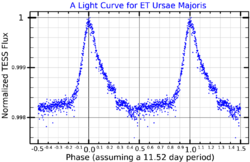Astronomy:HR 4072
| Observation data Equinox J2000.0]] (ICRS) | |
|---|---|
| Constellation | Ursa Major |
| Right ascension | 10h 24m 07.84801s[2] |
| Declination | +65° 33′ 59.1239″[2] |
| Apparent magnitude (V) | 4.94[3] |
| Characteristics | |
| Spectral type | A1:VpSiSrHg[4] |
| B−V color index | −0.052±0.012[3] |
| Variable type | α2 CVn[5] |
| Astrometry | |
| Radial velocity (Rv) | −2.6±4.2[3] km/s |
| Proper motion (μ) | RA: −9.427[2] mas/yr Dec.: −20.994[2] mas/yr |
| Parallax (π) | 9.61 ± 0.20[2] mas |
| Distance | 339 ± 7 ly (104 ± 2 pc) |
| Absolute magnitude (MV) | −0.15[3] |
| Orbit[6] | |
| Period (P) | 11.57907±0.00019 d |
| Eccentricity (e) | 0.26±0.04 |
| Periastron epoch (T) | 2,418,468.175±0.051 JD |
| Argument of periastron (ω) (secondary) | 171.0±1.6° |
| Semi-amplitude (K1) (primary) | 38.9±0.5 km/s |
| Semi-amplitude (K2) (secondary) | 64.8 km/s |
| Details | |
| A | |
| Luminosity | 138.84[3] L☉ |
| Surface gravity (log g) | 3.89[7] cgs |
| Temperature | 10,307[7] K |
| Metallicity [Fe/H] | +0.39[7] dex |
| Rotational velocity (v sin i) | 4.5[7] km/s |
| Other designations | |
| Database references | |
| SIMBAD | data |
HR 4072 is a binary star[9] system in the northern circumpolar constellation of Ursa Major. It has the variable star designation ET Ursae Majoris, abbreviated ET Uma,[5] while HR 4072 is the system's designation from the Bright Star Catalogue. It has a white hue and is faintly visible to the naked eye with an apparent visual magnitude that fluctuates around 4.94.[3] The system is located at a distance of approximately 339 light years from the Sun based on parallax measurements.[2] The radial velocity measurement is poorly constrained, but it appears to be drifting closer to the Sun at the rate of around −3 km/s.[3]
This is a double-lined spectroscopic binary[7] star system with an orbital period of 11.6 days and an eccentricity of 0.26. The orbit for this star was first determined by R. H. Baker in 1912, then later revised.[6]
The primary, designated component A, is an Ap type chemically-peculiar star[10][11][12] with a stellar classification of A1:VpSiSrHg,[4] although it has also been considered to be a mercury-manganese star.[13] The suffix notation indicates abundance anomalies of silicon, strontium, and mercury in the spectrum. It is an α2 Canum Venaticorum variable with an amplitude of 0.05 magnitude in the B (blue) band.[5] The star is rotating slowly with a projected rotational velocity of 4.5 km/s.[7] It is radiating 139[3] times the luminosity of the Sun from its photosphere at an effective temperature of 10,307 K.[7]
The secondary component has been reported to have characteristics of an Am star.[11]
References
- ↑ "MAST: Barbara A. Mikulski Archive for Space Telescopes". Space Telescope Science Institute. https://mast.stsci.edu/portal/Mashup/Clients/Mast/Portal.html.
- ↑ 2.0 2.1 2.2 2.3 2.4 2.5 Brown, A. G. A. (August 2018). "Gaia Data Release 2: Summary of the contents and survey properties". Astronomy & Astrophysics 616: A1. doi:10.1051/0004-6361/201833051. Bibcode: 2018A&A...616A...1G. Gaia DR2 record for this source at VizieR.
- ↑ 3.0 3.1 3.2 3.3 3.4 3.5 3.6 3.7 Anderson, E.; Francis, Ch. (2012). "XHIP: An extended hipparcos compilation". Astronomy Letters 38 (5): 331. doi:10.1134/S1063773712050015. Bibcode: 2012AstL...38..331A.
- ↑ 4.0 4.1 Abt, Helmut A.; Morrell, Nidia I. (1995). "The Relation between Rotational Velocities and Spectral Peculiarities among A-Type Stars". Astrophysical Journal Supplement 99: 135. doi:10.1086/192182. Bibcode: 1995ApJS...99..135A.
- ↑ 5.0 5.1 5.2 Samus, N. N. et al. (2017). "General Catalogue of Variable Stars". Astronomy Reports. 5.1 61 (1): 80–88. doi:10.1134/S1063772917010085. Bibcode: 2017ARep...61...80S.
- ↑ 6.0 6.1 Nariai, K. (1970). "Orbit of the Double-Line Spectroscopic Binary HR4072(Ap)". Publications of the Astronomical Society of Japan 22: 113. Bibcode: 1970PASJ...22..113N.
- ↑ 7.0 7.1 7.2 7.3 7.4 7.5 7.6 Takeda, Yoichi et al. (October 2018). "Photospheric carbon, nitrogen, and oxygen abundances of A-type main-sequence stars*". Publications of the Astronomical Society of Japan 70 (5): 91. doi:10.1093/pasj/psy091. 91. Bibcode: 2018PASJ...70...91T.
- ↑ "ET UMa". SIMBAD. Centre de données astronomiques de Strasbourg. http://simbad.u-strasbg.fr/simbad/sim-basic?Ident=ET+UMa.
- ↑ Eggleton, P. P.; Tokovinin, A. A. (September 2008). "A catalogue of multiplicity among bright stellar systems". Monthly Notices of the Royal Astronomical Society 389 (2): 869–879. doi:10.1111/j.1365-2966.2008.13596.x. Bibcode: 2008MNRAS.389..869E.
- ↑ Renson, P.; Manfroid, J. (2009). "Catalogue of Ap, HGMN and Am stars". Astronomy and Astrophysics 498 (3): 961. doi:10.1051/0004-6361/200810788. Bibcode: 2009A&A...498..961R.
- ↑ 11.0 11.1 Popper, Daniel M. (1971). "Some Double-Lined Eclipsing Binaries with Metallic-Line Spectra". The Astrophysical Journal 169: 549. doi:10.1086/151173. Bibcode: 1971ApJ...169..549P.
- ↑ Chen, P. S.; Liu, J. Y.; Shan, H. G. (2017). "A New Photometric Study of Ap and Am Stars in the Infrared". The Astronomical Journal 153 (5): 218. doi:10.3847/1538-3881/aa679a. Bibcode: 2017AJ....153..218C.
- ↑ Ghazaryan, S.; Alecian, G. (2016). "Statistical analysis from recent abundance determinations in Hg Mn stars". Monthly Notices of the Royal Astronomical Society 460 (2): 1912. doi:10.1093/mnras/stw911. Bibcode: 2016MNRAS.460.1912G.
 |


